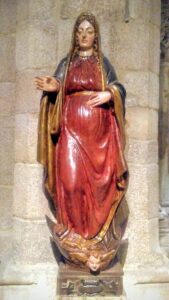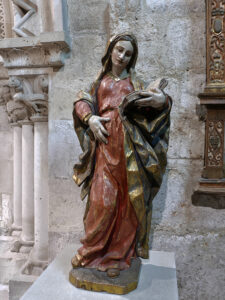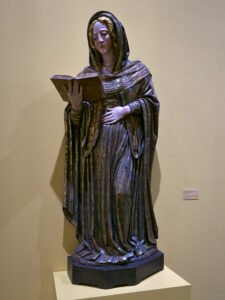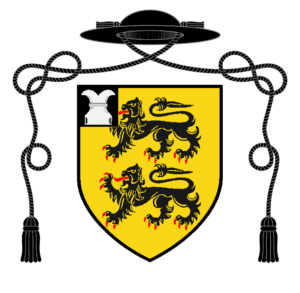Mass of the Expectation of the Blessed Virgin Mary
by Fr. William Rock, FSSP
In editions preceding the 1962 edition of the Roman Missal, in the section for Masses for particular places (Missæ Pro Aliquibus Locis), listed for December 18th, is the Mass of the Expectation of the Blessed Virgin Mary (In Exspectatione Partus B. Mariæ Virg.). In the Advent Volume of his Liturgical Year, Dom Prosper Guéranger explains the origin of this Mass, its associated Feast, and how it was kept as follows:
This feast, which is now kept not only throughout the whole of Spain but in many other parts of the Catholic world, owes its origin to the bishops of the tenth Council of Toledo, in 656. These prelates thought that there was an incongruity in the ancient practice of celebrating the feast of the Annunciation on the twenty-fifth of March, inasmuch as this joyful solemnity frequently occurs at the time when the Church is intent upon the Passion of our Lord, so that it is sometimes obliged to be transferred into Easter time, with which it is out of harmony for another reason; they therefore decreed that, henceforth, in the Church of Spain there should be kept, eight days before Christmas, a solemn feast with an octave, in honour of the Annunciation, and as a preparation for the great solemnity of our Lord’s Nativity. In course of time, however, the Church of Spain saw the necessity of returning to the practice of the Church of Rome, and of those of the whole world, which solemnize the twenty-fifth of March as the day of our Lady’s Annunciation and the Incarnation of the Son of God. But such had been, for ages, the devotion of the people for the feast of the eighteenth of December, that it was considered requisite to maintain some vestige of it. They discontinued, therefore, to celebrate the Annunciation on this day; but the faithful were requested to consider, with devotion, what must have been the sentiments of the holy Mother of God during the days immediately preceding her giving Him birth. A new feast was instituted, under the name of “the Expectation of the blessed Virgin’s delivery.”
This feast, which sometimes goes under the name of Our Lady of O, or the feast of O, on account of the great antiphons which are sung during these days, and, in a special manner, of that which begins O Virgo virginum (which is still used in the Vespers of the Expectation, together with the O Adonai, the antiphon of the Advent Office), is kept with great devotion in Spain. A High Mass is sung at a very early hour each morning during the octave, at which all who are with child, whether rich or poor, consider it a duty to assist, that they may thus honour our Lady’s Maternity, and beg her blessing upon themselves. It is not to be wondered at that the holy See has approved of this pious practice being introduced into almost every other country. We find that the Church of Milan, long before Rome conceded this feast to the various dioceses of Christendom, celebrated the Office of our Lady’s Annunciation on the sixth and last Sunday of Advent, and called the whole week following the Hebdomada de Exceptato (for thus the popular expression had corrupted the word Expectato). But these details belong strictly to the archaeology of liturgy, and enter not into the plan of our present work; let us, then, return to the feast of our Lady’s Expectation, which the Church has established and sanctioned as a new means of exciting the attention of the faithful during these last days of Advent.1
The Great Antiphon to Our Lady
O Virgo virginum, quomodo fiet istud? quia nec· primam similem visa es, nec habera sequentem. Filiae Jerusalem, quid me admiramini? Divinum est mysterium hoc quod cernitis.
O Virgin of virgins, how shall this be? for never was there one like thee, nor will there ever be. Ye daughters of Jerusalem, why look ye wondering at me? What ye behold, is a divine mystery.2

The Mass3 itself opens with the chant Rorate Caeli (Isa 45:8): “Drop down dew, ye heavens, from above, and let the clouds rain the just: let the earth be opened, and bud forth a saviour.” This is a prophecy of Christ, the Just One Who comes from Above, and the Blessed Virgin, who will give birth to the Savior. In addition to being the opening chant of several Masses during Advent, the text is also ubiquitous in the Office of the season. The Psalm verse is Psalm 18:2: “The heavens shew forth the glory of God, and the firmament declareth the work of his hands.” While this verse seems out of place, as it refers symbolically to the Apostles, it must be remembered that this is only the start of the Psalm and, as such, is meant to call to mind its entirety. Later on, verse 6 reads: “He hath set his tabernacle in the sun: and he as a bridegroom coming out of his bridechamber, Hath rejoiced as a giant to run the way.” It is very common for the womb of the Blessed Virgin to be seen as the bridechamber where God the Son entered into a nuptial relationship with humanity by assuming a Human Nature.4 The Common of the Blessed Virgin Mary in the Divine Office makes use of this Psalm in the first Nocturne. The Psalm verse sets this Mass proper apart from the Rorate Mass chant for the Saturdays during Advent (which uses Ps 84:2), but is the same as that used in the Rorate Introits of Ember Wednesday of Advent and of the Fourth Sunday of Advent.
The Collect (opening prayer) reads as follows:
Deus, qui de beátæ Maríæ Vírginis útero Verbum tuum, Angelo nuntiánte, carnem suscípere voluísti: præsta supplícibus tuis; ut, qui vere eam Genetrícem Dei crédimus, ejus apud te intercessiónibus adjuvémur. Per eúndem Dóminum…
O God, Who, by the message of an angel, willed Your Word to take flesh in the womb of the Blessed Virgin Mary, grant that we, Your suppliants, who believe her to be truly the Mother of God, may be helped by her intercession with You. Through the same Our Lord…5
This is the same as the Collects in the Mass of the Annunciation and in the Saturday Rorate Mass.
The Epistle is the prophecy of the Virgin Birth found in the seventh chapter of the Book of the Prophet Isaias (Isa 7:10-15), the same used on the Feast of the Annunciation, Ember Wednesday of Advent, and the Saturday Rorate Mass.
The Gradual is taken from Psalm 23:7, 3-4: “Lift up your gates, O ye princes, and be ye lifted up, O eternal gates: and the King of Glory shall enter in. ℣. Who shall ascend into the mountain of the Lord: or who shall stand in his holy place? The innocent in hands, and clean of heart.” The first part, in this context, would seem to indicate the preparation the world should be undertaking to prepare for the One soon to be born, soon to enter into this world. The second part describes the perfections of the One Who is to Come. These lines are also the Gradual for the Ember Wednesday during Advent, and Psalm 23:7 is the text of the Offertory of the Mass of the Vigil of Christmas.

The Alleluia alludes to the prophecy heard in the Epistle and Luke 1:31: “Behold, a Virgin shall conceive and bear a Son, Jesus Christ.” While similar to others, this chant, due to its conclusion, is unique.
The Gospel is the account of the Annunciation found in the Gospel of Luke (1:26-38), the same used on the Feast of the Annunciation, Ember Wednesday of Advent, and the Saturday Rorate Mass.
The Offertory chant is also taken from the Gospel of Luke (1:28, 42), combining the greetings of the Archangel Gabriel and Mary’s kinswoman Elizabeth: “Hail, full of grace, the Lord is with thee: blessed art thou among women: blessed art thou among women and blessed is the fruit of thy womb.” This is the familiar beginning of the Hail Mary. The same chant is used as the Offertory for the Feast of the Annunciation, the Saturday Rorate Mass, and the Fourth Sunday of Advent.
The Secret (prayer over the gifts) is the same as that prayed on the Feast of the Annunciation and the Saturday Rorate Mass:
In méntibus nostris, quǽsumus, Dómine, veræ fídei sacraménta confírma: ut, qui concéptum de Vírgine Deum verum et hóminem confitémur; per ejus salutíferæ resurrectiónis poténtiam, ad ætérnam mereámur perveníre lætítiam. Per eúndem Dóminum nostrum….
Fix firmly in our minds, O Lord, we beseech You, the mysteries of the true faith; that we who believe Him, conceived of a Virgin, to be true God and man, may be found worthy to reach eternal happiness through the power of His redeeming resurrection. Through the same Our Lord…
The Communion chant is taken from the Isaias’ Prophecy (Isa 7:14): “Behold a virgin shall conceive, and bear a son and his name shall be called Emmanuel.” The same is used on the Feast of the Annunciation, Ember Wednesday of Advent, the Fourth Sunday of Advent, and the Saturday Rorate Mass.
The Postcommunion (closing prayer) is familiar as the prayer used in the Angelus:
Grátiam tuam, quǽsumus, Dómine, méntibus nostris infúnde: ut, qui, Angelo nuntiánte, Christi, Fílii tui, incarnatiónem cognóvimus; per passiónem passiónem ejus et crucem, ad resurrectiónis glóriam perducámur. Per eúndem Dóminum…
Pour forth, we beseech You, O Lord, Your grace into our hearts, that we, to whom the incarnation of Christ, Your Son, was made known by the message of an angel, may, by His passion and cross, be brought to the glory of the resurrection. Through the same Our Lord…

This prayer is also used as the Postcommunion in the Mass of the Annunciation and the Saturday Rorate Mass.
Besides the Alleluia, the Mass of the Expectation of the Blessed Virgin Mary shares many propers with the Marian Masses of the Annunciation and the Rorate Mass of Our Lady on Saturdays during Advent along with the Masses of Ember Wednesday in Advent (which itself also commemorates the Annunciation) and the Fourth Sunday in Advent. So, while the texts of this Mass are not overly unique, it is the spirit associated with the Mass which sets it apart, a spirit captured by Dom Guéranger in the lines already quoted above and expressed in the form of the below prayer to Our Lady.
Most just indeed it is, O holy Mother of God, that we should unite in that ardent desire thou hadst to see Him, who had been concealed for nine months in thy chaste womb; to know the features of this Son of the heavenly Father, who is also thine; to come to that blissful hour of His birth, which will give glory to God in the highest, and, on earth, peace to men of good-will. Yes, dear Mother, the time is fast approaching, though not fast enough to satisfy thy desires and ours. Make us redouble our attention to the great mystery; complete our preparation by thy powerful prayers for us, that when the solemn hour has come, our Jesus may find no obstacle to His entrance into our hearts.6
Fr. Wiliam Rock, FSSP was ordained in the fall of 2019 and is currently assigned to Regina Caeli Parish in Houston, TX.
- Guéranger, Prosper. The Liturgical Year, vol. 1 (Advent). Trans. Shepherd, Laurence. (Fitzwilliam: Loreto Publications, 2000), pp. 588-486.
- Ibid., p. 490
- The Propers of the Mass were taken from this edition of the Roman Missal.
- See, for example, Guéranger’s Advent, p. 156.
- Translations of the orations are taken from The Divinum Officium Project.
- Guéranger, pp. 489-490.
December 18, 2023









